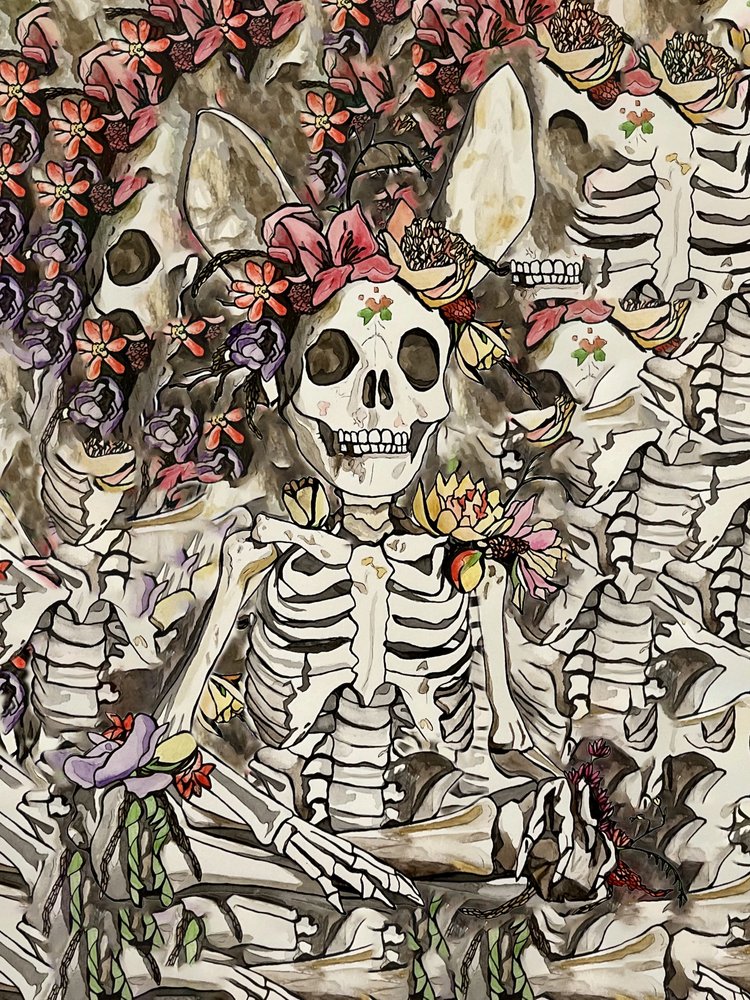Most people hearing the term „endangered species” think of grizzly bears, manatees or whales rather than small wildlife animals. Although many of these small creatures are unknown to us, they are important parts of our ecosystem. While seeing them slowly disappear is tragic, their losses will also cause a ripple through the ecosystem impacting others.
Photo Credits to Tom Reinke
I started painting murals of endangered species in the Bay Area to celebrate these threatened animals and plants, which live in our region and are headed extinction. In the beginning I painted butterfly murals, depicting the Lange's Metalmark, the Callippe Silverspot, and the Monarch Butterfly to spread awareness. I recently added endangered reptiles like the California Red-Legged Frog and the California Tiger Salamander to my Public Art Collection. So far, I painted nine utility boxes all around the Bay Area. My series will continue with four more boxes completing the endangered species list with birds and mammals like the Northern Spotted Owl and the San Joaquin Kit Fox next year.
Photo Credits to Tri-Valley TV (Channel 30)
I think the first step to protect endangered species is learning about the wildlife near you. For my research on the Tri-Valley area, I visited the Callippe Preserve in Pleasanton. You can discover many native animals and plants on their 3.75-mile long trail, which also offers spectacular views. I was eager to hear how hard the golf course is working to protect these endangered and threatened animals. They have many areas designated for the Callippe Silverspot Butterfly habitats, that also includes the habitat of the California Red-Legged Frog and the California Tiger Salamander.
California Red-Legged Frog
The California Red-Legged Frog is a rare species of frog found almost exclusively in the state of California. It became famous for being the frog featured in Mark Twain's short story “The Celebrated Jumping Frog of Calaveras County.” Today, the California Red-Legged Frog is on the endangered species list, because it is threatened by invasive species and habitat loss. In 2015, a new law designates the California Red-Legged Frog the “State Amphibian.”
California Tiger Salamander
Photo Credits to Richard Lee
The California Tiger Salamander is also a very vulnerable amphibian native to California. With its wide mouth charmingly outlined, the California Tiger Salamander always looks like it is smiling. But this beautiful amphibian is extremely rare now, since his habitats like vernal pools, grasslands, and oak woodlands are disappearing more and more.
Scientists say the greatest threat, that these species face is the destruction of their habitat. Therefore, the best way to ensure the survival of endangered animals is to protect the places where they find food, shelter and raise their young. You can support and help protect open spaces in your community. Make your backyard wildlife friendly by seeding native plants, which provide food and shelter. It is important to use alternatives to pesticides and herbicides. Many amphibians are particularly vulnerable to the chemical pollutants. Pesticides and herbicides can take a long time to degrade and build up in the soil. Especially amphibians like the California Red-Legged Frog and the Tiger Salamander suffer as a result of the high levels of chemical pollutants in their habitat. But also predators such as hawks, owls, foxes and coyotes can be harmed if they eat poisoned animals. The cycle continues in the food chain and brings numerous negative effects on the environment and on the ecosystem. If these species are wiped out, their losses will also affect other animals, which depend on them as food supply and the cycle of extinction will continue.






